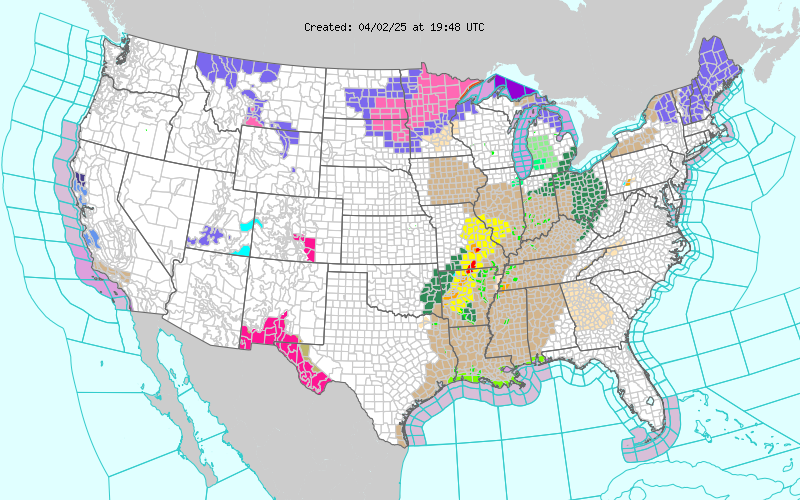
Severe thunderstorms are defined by the National Weather Service as downdraft winds in excess of 58 miles an hour and/or hail 1 inch in diameter or greater.
Severe thunderstorms are reported each year in all New Mexico counties. Severe thunderstorms peak in the east during April through June and statewide July through August.
The Storm Prediction Center in Norman, Oklahoma issues a SEVERE THUNDERSTORM WATCH to give you advance notice that severe thunderstorms are possible in your area. This gives you time to make preliminary plans for moving to a safe location if a severe thunderstorm warning is issued. The SPC also issues convective outlooks (see below) for days 1 through 3.
|
|
 |  |  |
| | |
A SEVERE THUNDERSTORM WARNING is an urgent announcement that a severe thunderstorm has been reported or is imminent and warns you to take cover. Severe thunderstorm warnings are issued by local NWS offices.
What you can do before a storm strikes...
- Know the county you are located in and the names of the major nearby cities or towns.
- Severe weather warnings and statements are issued by county and reference major cities.
- Check the latest weather forecast and hazardous weather outlook.
- Watch for signs of an approaching thunderstorm.
- If a storm is approaching, tune to NOAA Weather Radio and/or AM/FM radio.
- Postpone outdoor activities if thunderstorms are imminent. This is your best way to avoid being caught in a dangerous situation.
When thunderstorms approach...
Outdoors:
- REMEMBER if you can hear thunder, you are close enough to a storm to be struck by lightning.
- If possible, move to a sturdy building or hard top automobile.
- If safe shelter is not available, find a low spot away from trees, fences, and poles.
- Squat low to the ground on the balls of your feet, place your hands on your knees with your head between them.
- Make yourself the smallest target possible and minimize your contact with the ground.
- Do not take shelter in small sheds, rock outcroppings, under isolated trees, or in convertible automobiles.
- If boating or swimming, get out of boats and away from the water, get to land and find shelter immediately.
- When boating, always stay tuned to the latest weather reports and return to safe harbor before the strong winds arrive.
Indoors:
- Stay away from windows and go to the safest location on the lowest level of your home.
- Unplug unnecessary appliances and only use the phone for emergencies.
- Mobile homes are especially vulnerable to the high winds of a thunderstorm and are subject to overturning and rolling if not properly anchored to the ground. As a minimum, the frame should be secured with heavy steel straps. Heavy straps should also go over the top of the home with both frame and over the top ties secured in concrete footings.

A tornado is defined as a violently rotating column of air that is touching the ground. Tornado wind speeds vary from 40 miles an hour for the weakest up to 300 miles an hour or greater for the most violent.Tornadoes are most common in eastern New Mexico in the spring, but they can occur anywhere. There have been tornado deaths in western areas of the state and near mountain communities. Here's some facts on tornadoes (and hail) in New Mexico.
The Storm Prediction Center in Norman, Oklahoma issues a TORNADO WATCH to give you advance notice that tornadoes are possible in your area. This gives you time to make preliminary plans for moving to a safe location if a tornado warning is issued.
A TORNADO WARNING is an urgent announcement that a tornado has been reported or is imminent and warns you to take cover immediately. The following are instructions on what to do when a tornado warning has been issued for your area or whenever a tornado threatens: IN HOMES OR SMALL BUILDINGS:
- Act quickly; seconds save lives.
- Go to the basement (if available) or to an interior room on the lowest floor, such as a closet or bathroom.
- If possible, get under a sturdy table or workbench.
- Wrap yourself in overcoats or blankets to protect yourself from flying debris.
- Be sure to stay clear of any threat of flying glass.
IN MOBILE HOMES, AUTOMOBILES, OR RVs:
ABANDON THEM IMMEDIATELY!! Most deaths occur in cars and mobile homes. If you are in either of those locations, leave them and go to a substantial structure or designated tornado shelter.
Mobile homes provide no shelter in a tornado regardless of how well tied down, and should be abandoned for a storm shelter.
if you live in a mobile home, be sure you have a plan of safe action should the weather become threatening.
If no shelter is available, lie flat in a ditch or depression in the ground and use your hands to cover your head.
IN SCHOOLS, HOSPITALS, FACTORIES, OR SHOPPING CENTERS:
IN HIGH-RISE BUILDINGS:
- Go to interior small rooms or halls. Stay away from exterior walls or glassy areas.
|
|
The Truth Is Stranger Than Fiction!
My Web Page Is Best Viewed With Google Chrome.
















Comments
Post a Comment
Your comments, questions, and feedback on this post/web page are welcome.